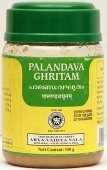Patha, Pāṭhā, Pāṭha, Paṭha: 37 definitions
Introduction:
Patha means something in Buddhism, Pali, Hinduism, Sanskrit, Jainism, Prakrit, the history of ancient India, Marathi, Hindi, biology. If you want to know the exact meaning, history, etymology or English translation of this term then check out the descriptions on this page. Add your comment or reference to a book if you want to contribute to this summary article.
Images (photo gallery)
In Hinduism
Ayurveda (science of life)
Cikitsa (natural therapy and treatment for medical conditions)
Source: Wisdom Library: Ayurveda: Cikitsa1) Pāṭhā (पाठा) is a Sanskrit word referring to Cissampelos pareira (velvetleaf), a species of flowering plant from the Menispermaceae family. Certain plant parts of Pāṭhā are eaten as a vegetable (śāka), according to Caraka in his Carakasaṃhitā sūtrasthāna (chapter 27), a classical Ayurvedic work. The plant is therefore part of the Śākavarga group of medicinal plants, referring to the “group of vegetables/pot-herbs”. Caraka defined such groups (vargas) based on the dietic value of the plant. The word Pāṭhā is derived from Pāṭha, which means “recitation” or “recital”. It is derived from the root paṭh.
According to the Mādhavacikitsā (7th-century Ayurvedic work), this plant (Pāṭhā) is mentioned as a medicine used for the treatment of all major fevers, as described in the Jvaracikitsā (or “the treatment of fever”) chapter.
According to the Rājanighaṇṭu (verses 6.119-121), Pāṭhā has the following synonyms: Ambaṣṭhā, Ambaṣṭhikā, Prācīnā, Pāpacelikā, Pāṭhikā, Sthāpanī, Śreyasī, Vṛddhikarṇikā, Ekāṣṭhīlā, Kucailī, Dīpanī, Varatiktakā, Tiktapuṣpā, Bṛhattikta, Dīpanī, Triśirā, Vṛkī, Mālavī, Varā, Devī and Vṛttaparṇī. The Rājanighaṇṭu is a 13th-century Āurvedic encyclopedia.
Properties according to the Carakasaṃhitā: The vegetables of Pāṭha alleviate three doṣas and are constipating.
Properties according to the Rājanighaṇṭu: Pāṭhā is bitter, heavy (guru) and hot. It relieves the vāta-pitta-jvara (fever due to vāta-pitta). It helps in uniting the fractures (bhagna-sandhāna-kṛt). It is useful in burning sensations, diarrhoea and colic.
Botanical description: It is a climber shrub with pubsescent leaves on both surfaces and small yellowish flowers (male and female separate), grows abunduntly throughout India. Its two varieties, Laghupāṭhā and Rājapāṭhā) are common. Rājapāṭhā is identified as Cyclea peltata, male and female climbers are separate.
2) Pāṭhā (पाठा) is a Sanskrit word referring to the Cyclea peltata (“pata root”), a species of flowering plant from the Menispermaceae family. It is also known as Pāṭhī in the Hindi language or as Pāṭavaḷḷi in the Malayalam language. It is used throughout Ayurvedic literature such as the Caraka-saṃhitā and the Suśruta-saṃhitā.
3) Paṭha (पठ):—Another name for Padmaka (Prunus majestica), a species of medicinal plant and used in the treatment of fever (jvara), as described in the Jvaracikitsā (or “the treatment of fever”) which is part of the 7th-century Mādhavacikitsā, a Sanskrit classical work on Āyurveda.
Source: Ancient Science of Life: Botanical identification of plants described in Mādhava CikitsāPāṭhā (पाठा) refers to the medicinal plant Cissampelos pareira L. var hirsuta Buch. Ham. Ex DC, and is used in the treatment of atisāra (diarrhoea), according to the 7th century Mādhavacikitsā chapter 2. Atisāra refers to a condition where there are three or more loose or liquid stools (bowel movements) per day or more stool than normal. The second chapter of the Mādhavacikitsā explains several preparations [including Pāṭhā] through 60 Sanskrit verses about treating this problem.
Note: Cyclea peltata Hook F. and Thoms. is called Rajapāṭhā and is used as a substitute for Pāṭhā.
Kalpa (Formulas, Drug prescriptions and other Medicinal preparations)
Source: Shodhganga: Edition translation and critical study of yogasarasamgrahaPāṭhā (पाठा) refers to the medicinal plant known as “Cyclea peltata (Lam.) Hook.f. & Thoms.” and is dealt with in the 15th-century Yogasārasaṅgraha (Yogasara-saṅgraha) by Vāsudeva: an unpublished Keralite work representing an Ayurvedic compendium of medicinal recipes. The Yogasārasaṃgraha [mentioning pāṭhā] deals with entire recipes in the route of administration, and thus deals with the knowledge of pharmacy (bhaiṣajya-kalpanā) which is a branch of pharmacology (dravyaguṇa).
Toxicology (Study and Treatment of poison)
Source: Shodhganga: Kasyapa Samhita—Text on Visha ChikitsaPatha (पथ) refers to “streets”, as taught in the Kāśyapa Saṃhitā: an ancient Sanskrit text from the Pāñcarātra tradition dealing with both Tantra and Viṣacikitsā—an important topic from Āyurveda which deals with the study of Toxicology (Agadatantra or Sarpavidyā).—The Kāśyapasaṃhitā mentions that snake-bites that happen in certain places [like a meeting point of four streets (catur-patha)] are highly inimical to the victim.

Āyurveda (आयुर्वेद, ayurveda) is a branch of Indian science dealing with medicine, herbalism, taxology, anatomy, surgery, alchemy and related topics. Traditional practice of Āyurveda in ancient India dates back to at least the first millenium BC. Literature is commonly written in Sanskrit using various poetic metres.
Dharmashastra (religious law)
Source: Wisdom Library: Dharma-śāstraPāṭha (पाठ) is a Sanskrit word, identified with Stephania hernandifolia (Kashmir tree) by various scholars in their translation of the Śukranīti. This tree is mentioned as having thorns, and should therefore be considered as wild. The King shoud place such trees in forests (not in or near villages). He should nourish them by stoole of goats, sheep and cows, water as well as meat. Note that Stephania hernandifolia is possibly a synonym of Stephania japonica (snake vine).
The following is an ancient Indian horticultural recipe for the nourishment of such trees:
According to Śukranīti 4.4.110-112: “The powder of the dungs of goats and sheep, the powder of Yava (barley), Tila (seeds), beef as well as water should be kept together (undisturbed) for seven nights. The application of this water leads very much to the growth in flowers and fruits of all trees (such as pāṭha).”

Dharmashastra (धर्मशास्त्र, dharmaśāstra) contains the instructions (shastra) regarding religious conduct of livelihood (dharma), ceremonies, jurisprudence (study of law) and more. It is categorized as smriti, an important and authoritative selection of books dealing with the Hindu lifestyle.
Vyakarana (Sanskrit grammar)
Source: Wikisource: A dictionary of Sanskrit grammar1) Pāṭha (पाठ).—Recital of a sacred Vedic or Sastra work; the original recital of an authoritative text;
2) Pāṭha.—The various artificial ways or methods of such a recital; c.g. पदपाठ, क्रमपाठ (padapāṭha, kramapāṭha) etc. in the case of Vedic Literature:
3) Pāṭha.—An original recital such as the सुत्रपाठ, धातुपाठ, गणपाठ, वार्तिकपाठ (sutrapāṭha, dhātupāṭha, gaṇapāṭha, vārtikapāṭha) and परिभाषापाठ (paribhāṣāpāṭha) in the case of the several systems of Sanskrit Grammar; the five Paathas are called पञ्चपाठी (pañcapāṭhī);
4) Pāṭha.—Recitation; cf. नान्तरेण पाठं स्वरा अनुबन्धा वा शक्या विज्ञातुम् (nāntareṇa pāṭhaṃ svarā anubandhā vā śakyā vijñātum) M. Bh. on P.I.3.1 Vaart. 13;
5) Pāṭha.—Reading, variant: cf. चूर्णादीनि अप्राण्युपग्रहादिति सूत्रस्य पाठान्तरम् (cūrṇādīni aprāṇyupagrahāditi sūtrasya pāṭhāntaram) Kaas. on P.V.2.134.

Vyakarana (व्याकरण, vyākaraṇa) refers to Sanskrit grammar and represents one of the six additional sciences (vedanga) to be studied along with the Vedas. Vyakarana concerns itself with the rules of Sanskrit grammar and linguistic analysis in order to establish the correct context of words and sentences.
Shaktism (Shakta philosophy)
Source: Google Books: ManthanabhairavatantramPatha (पथ) refers to “roads”, according to the Manthānabhairavatantra, a vast sprawling work that belongs to a corpus of Tantric texts concerned with the worship of the goddess Kubjikā.—Accordingly, “(Bali is offered) in the sacred seats, primary and secondary, in a sacred field, in a cremation ground, at a crossing of three or four roads, (under) a solitary tree, on the banks of a river, to a Siddha Liṅga, on roads [i.e., patha], in the directions, in the Wheel of the Transmission, during an eclipse of the sun or moon, and on all important sacred days, particularly on those concerning the teacher”.

Shakta (शाक्त, śākta) or Shaktism (śāktism) represents a tradition of Hinduism where the Goddess (Devi) is revered and worshipped. Shakta literature includes a range of scriptures, including various Agamas and Tantras, although its roots may be traced back to the Vedas.
Jyotisha (astronomy and astrology)
Source: Wisdom Library: Brihat Samhita by VarahamihiraPātha (पाथ) refers to “travellers”, according to the Bṛhatsaṃhitā (chapter 9), an encyclopedic Sanskrit work written by Varāhamihira mainly focusing on the science of ancient Indian astronomy astronomy (Jyotiṣa).—Accordingly, “If the course of Saturn should just precede that of Venus, the Mlecchas, cats, elephants, asses, buffaloes, black grains, hogs, Pulindas (barbarians), the Śūdras and travellers in the south [i.e., sa-dakṣiṇā-pātha] will suffer by diseases of the eye and by windy disorders. If the course of Mars should just precede that of Venus, mankind will suffer from fire, from weapons, from hunger, from drought and from thieves; all the creatures and objects of the north will suffer and the sky will be filled with fire, lightning and dust”.

Jyotisha (ज्योतिष, jyotiṣa or jyotish) refers to ‘astronomy’ or “Vedic astrology” and represents the fifth of the six Vedangas (additional sciences to be studied along with the Vedas). Jyotisha concerns itself with the study and prediction of the movements of celestial bodies, in order to calculate the auspicious time for rituals and ceremonies.
Vaishnavism (Vaishava dharma)
Source: Brill: Śaivism and the Tantric Traditions (vaishnavism)Patha (पथ) refers to a “traveler”, according to the Vedānta Deśika’s Yatirājasaptati.—When we come to the poem’s understanding of the divinity of Rāmānuja we find a wide spectrum of meanings. [...] Verse 28 is particularly eloquent in describing and encapsulating all his nurturing and protecting qualities, which are compared to those present everywhere in nature itself—as the mountain from which originate all the streams of knowledge, the tree under which the weary traveler wandering (patha) in saṃsāra takes rest, the rising sun that keeps the illusionary darkness of those with distorted views at bay and the full moon that brings to high tide the ocean of the Vedas.

Vaishnava (वैष्णव, vaiṣṇava) or vaishnavism (vaiṣṇavism) represents a tradition of Hinduism worshipping Vishnu as the supreme Lord. Similar to the Shaktism and Shaivism traditions, Vaishnavism also developed as an individual movement, famous for its exposition of the dashavatara (‘ten avatars of Vishnu’).
Yoga (school of philosophy)
Source: Brill: Śaivism and the Tantric Traditions (yoga)Patha (पथ) refers to the “pathways” (in the spaces), according to the Amṛtasiddhi, a 12th-century text belonging to the Haṭhayoga textual tradition.—Accordingly, “The sphere of the sun is at the base of the Central Channel, complete with twelve digits, shining with its rays. The lord of creatures (Prajāpati), of intense appearance, travels upwards on the right. Staying in the pathways in the spaces (ākāśa-patha) in the channels it pervades the entire body. The sun consumes the lunar secretion, wanders in the sphere of the wind and burns up all the bodily constituents in all bodies”.

Yoga is originally considered a branch of Hindu philosophy (astika), but both ancient and modern Yoga combine the physical, mental and spiritual. Yoga teaches various physical techniques also known as āsanas (postures), used for various purposes (eg., meditation, contemplation, relaxation).
In Buddhism
Tibetan Buddhism (Vajrayana or tantric Buddhism)
Source: academia.edu: A Critical Study of the Vajraḍākamahātantrarāja (II)Pāṭhā (पाठा) is the name of a plant mentioned in connection with a Tantric ceremony, according to the Vajraḍākatantra chapter 38.—Five techniques to please Dūtīs as well as the Yogin himself and to enlarge a Yogin’s gentials are introduced. Various kinds of woods and plants in addition to honey and butter are utilized for this purpose. [...] The mixture of aśvagandhā, pāṭhā, kaṭurohiṇī and sap of arka-tree is effective for growing his genitals.

Tibetan Buddhism includes schools such as Nyingma, Kadampa, Kagyu and Gelug. Their primary canon of literature is divided in two broad categories: The Kangyur, which consists of Buddha’s words, and the Tengyur, which includes commentaries from various sources. Esotericism and tantra techniques (vajrayāna) are collected indepently.
Mahayana (major branch of Buddhism)
Source: Wisdom Library: Maha Prajnaparamita SastraPatha (पथ) refers to the “(good) path”, according to the 2nd century Mahāprajñāpāramitāśāstra chapter 46.—Accordingly, “Beings who hear these exhortations are ‘established in the perfection of exertion’. [...] [To all, the Bodhisattva says:] Do not give yourself up to empty and ineffective laziness. Poor people and lowly people are afflicted by all kinds of painful efforts, but laziness is the lowest of the faults: it destroys the benefits and good paths (kuśala-patha) of the present life and the future life. [...]”.
Source: academia.edu: A Study and Translation of the GaganagañjaparipṛcchāPatha (पथ) refers to the “way (of awakening)”, according to the Gaganagañjaparipṛcchā: the eighth chapter of the Mahāsaṃnipāta (a collection of Mahāyāna Buddhist Sūtras).—Accordingly: “[...] Having bowed to the feet of the Tathāgata, Siṃha and Siṃhavikrāntagāmin, the noble ones who are skilled in the meaning of the dharma, uttered these verses: ‘[...] (175) This king longs for riches and happiness, is captivated by form, sound, and smell, never makes any offering, and does not even come to the nearness [of the Tathāgata.] How could he hear the dharma? (176) O protector, by producing compassion, in order that all beings may listen to the highest path and never turn away from it, please teach the most excellent way of awakening (bodhi-patha). [...]’”.

Mahayana (महायान, mahāyāna) is a major branch of Buddhism focusing on the path of a Bodhisattva (spiritual aspirants/ enlightened beings). Extant literature is vast and primarely composed in the Sanskrit language. There are many sūtras of which some of the earliest are the various Prajñāpāramitā sūtras.
In Jainism
General definition (in Jainism)
Source: The University of Sydney: A study of the Twelve ReflectionsPatha (पथ) refers to the “path (of bad conduct)” (subject to wrong faith), according to the 11th century Jñānārṇava, a treatise on Jain Yoga in roughly 2200 Sanskrit verses composed by Śubhacandra.—Accordingly, “Having assented to your own births in the forest of life, the pain you have been suffering previously for a long time by roaming about on the path of bad conduct (durnaya-patha-bhrānta) subject to wrong faith is [like] an external fire. Now, having entered the self which is cherishing the end of all restlessness, wise, solitary, supreme [and] self-abiding, may you behold the beautiful face of liberation. [Thus ends the reflection on] difference [between the body and the self]”.
Synonyms: Mārga, Pathin.

Jainism is an Indian religion of Dharma whose doctrine revolves around harmlessness (ahimsa) towards every living being. The two major branches (Digambara and Svetambara) of Jainism stimulate self-control (or, shramana, ‘self-reliance’) and spiritual development through a path of peace for the soul to progess to the ultimate goal.
India history and geography
Source: archive.org: Personal and geographical names in the Gupta inscriptionsPatha (पथ) refers to a name-ending for place-names mentioned in the Gupta inscriptions (reigned from 3rd century CE). Patha means a “way”, “path”, a “road” or “route”. In the Samarāṅgaṇasūtradhāra we find the word janṅhā-patha (foot-path). The suffix ‘patha’ has been used as early as the later Vedic period. Originally patha meant ‘a path’, ‘a road’ but later on it came to denote ‘a country’. Even now-a-days, the suffix ‘road’ is used for inhabitations and localities.
Source: Early History Of The Deccan Pts.1 To 6: Principal Administrative Divisions from the Rise of the SātavāhanasPatha (पथ) refers to an “administrative unit”.—Side by side with the raṭṭha or rāṣṭra we find another group of administrative units whose names end in -patha. An early Pallava inscription refers to the Andhrāpatha in charge of an official (vāpata or Vyāpṛta) at Dhaṃñakaḍa, usually identified with Amarāvatī or some neighbouring place. Epigraphs of about the same age also mention Paiṭhāṇa-patha (apparently connected with Paiṭhaṇ on the Godāvarī), Śvetapatha, and Kāchu-patha (Kācupatha).
Source: Shodhganga: A study of place names of Nalgonda districtPatha is a term designating ‘road’, used in the inscriptions of Andhra Pradesh.—These two appellations (patha and marga) are synonymous, standing for trade-communication routes or village roads. Understands pathaka as a term similar to a pargana of later days. Divisions with these appellations occur very rarely in Andhra Pradesh. Ane-marga was a division of the Kalyana Chalukyas and Ongeru-marga-vishaya was that of the Eastern Chalukyas. The Mayidavolu plates of the Pallava king Sivaskandavarman refer to Andhra-patha which might mean not an administrative unit, but the entire Andhra region ruled by the Pallavas. In Madhya Pradesh under the Vakatakas and the Sarabhapuriyas there were a large number of marga divisions.
Source: What is India: Inscriptions of the Candellas, Kacchapaghatas, Pala, etc.Patha is the name of a city mentioned in the “Semrā copper-plate grant of Paramardideva” (1162 A.C). Patha, as read by Cartellieri in ll. 8-9, has been identified by him with the modern place of the same name lying about 6 kms. east of Berwārā.
These plates (mentioning Patha) were found at Semrā: a town in the Chatarpur District of the Bundelkhand region (formerly the state of Bijāwar) of Madhya Pradesh. They were issued by Paramardideva to record the confirmation of a grant, from his camp at Sonasara, for the sake of the increase of his own and his parent’s merit and fame.
Source: Cologne Digital Sanskrit Dictionaries: Indian Epigraphical GlossaryPātha.—(IE 8-6; IA 11), a land measure regarded as equal to 240 square feet. Note: pātha is defined in the “Indian epigraphical glossary” as it can be found on ancient inscriptions commonly written in Sanskrit, Prakrit or Dravidian languages.

The history of India traces the identification of countries, villages, towns and other regions of India, as well as mythology, zoology, royal dynasties, rulers, tribes, local festivities and traditions and regional languages. Ancient India enjoyed religious freedom and encourages the path of Dharma, a concept common to Buddhism, Hinduism, and Jainism.
Biology (plants and animals)
Source: Wisdom Library: Local Names of Plants and DrugsPatha [ପାଠା] in the Oriya language is the name of a plant identified with Cyclea peltata Hook. fil. & Thoms. from the Menispermaceae (Moonseed) family having the following synonyms: Cyclea burmanii, Cyclea versicolor, Cyclea discolor. For the possible medicinal usage of patha, you can check this page for potential sources and references, although be aware that any some or none of the side-effects may not be mentioned here, wether they be harmful or beneficial to health.
Patha [पाठा] in the Nepali language is the name of a plant identified with Stephania japonica (Thunb.) Miers from the Menispermaceae (Moonseed) family having the following synonyms: Menispermum japonicum, Cissampelos hemandifolia, .
Patha [पाठा] in the Nepali language is the name of a plant identified with Cissampelos pareira var. hirsuta (Buch.-Ham. ex DC.) from the Menispermaceae (Moonseed) family having the following synonyms: Cissampelos hirsuta, Cissampelos nepalensis, Cissampelos cordifolia.
Patha [پاٹھا] in the Urdu language, ibid. previous identification.
Source: Google Books: CRC World Dictionary (Regional names)1) Patha in India is the name of a plant defined with Cissampelos pareira in various botanical sources. This page contains potential references in Ayurveda, modern medicine, and other folk traditions or local practices It has the synonym Chondrodendron tomentocarpum (Rusby) Moldenke (among others).
2) Patha is also identified with Kydia calycina It has the synonym Kydia roxburghiana Wight (etc.).
3) Patha is also identified with Stephania glabra It has the synonym Cissampelos glabra Buch.-Ham. ex Wight & Arn. (etc.).
4) Patha is also identified with Stephania hernandifolia It has the synonym Clypea discolor Blume (etc.).
5) Patha is also identified with Stephania japonica It has the synonym Menispermum japonicum Thunb. (etc.).
Example references for further research on medicinal uses or toxicity (see latin names for full list):
· Florae Fluminensis Icones
· Bijdragen tot de flora van Nederlandsch Indië (1825)
· Contrib. Bot. (1871)
· Repertorium Botanices Systematicae. (Walpers) (1842)
· The Annals and magazine of natural history; zoology, botany, and geology (1851)
· Flora Japonica (1784)
If you are looking for specific details regarding Patha, for example chemical composition, side effects, health benefits, diet and recipes, pregnancy safety, extract dosage, have a look at these references.

This sections includes definitions from the five kingdoms of living things: Animals, Plants, Fungi, Protists and Monera. It will include both the official binomial nomenclature (scientific names usually in Latin) as well as regional spellings and variants.
Languages of India and abroad
Pali-English dictionary
Source: BuddhaSasana: Concise Pali-English Dictionarypatha : (m.) path; way; road (in cpds.) range of, e.g. gaṇanapatha = range of calculation. || pāṭha (m.) a passage; text reading.
Source: Sutta: The Pali Text Society's Pali-English DictionaryPāṭha, (fr. paṭh) reading, text-reading; passage of a text, text. Very frequent in Commentaries with phrase “ti pi pāṭho, ” i.e. “so is another reading, ” e.g. KhA 78, 223; SnA 43 (°ṃ vikappeti), 178, 192, 477; PvA. 25 (pamāda° careless text), 48, 58, 86 and passim. (Page 451)
— or —
Patha, (of path, Ved. pathi with the 3 bases pathi, path° and panth°, of which only the last two have formed independent nouns, viz. patha and pantha (q. v.)) 1. path, road, way D. I, 63; Sn. 176 (Loc. pathe), 385, 540, 868; Nd2 485 B (+pantha, in explanation of magga); J. I, 308 (Loc. pathe); II, 39; VI, 525 (Abl. pathā); Th. 1, 64; Pug. 22, 57; Mhvs 21, 24 (pathe); 36, 93 (Loc. pathi, see Geiger, Gr. § 89); Sdhp. 241.—2. Very frequent as —°, where it is sometimes pleonastic, and acts in the function of an abstract formation in °tā or °ttaṃ (cp. similar use of anta: see anta1 5; and pada: see pada 3), e.g. anila° (air) J. IV, 119; anupariyāya° A. IV, 107; ādicca° (path of the sun, sky) DhA. III, 177; ummagga° S. I, 193; kamma° DhA. I, 36; gaṇana° (range of) calculation Miln. 20; cakkhu° J. IV, 403 (=cakkhūnaṃ etaṃ nāmaṃ C.); catummahā° A. III, 28, 42, 394; dve° Vv 5317; nakkhatta° Dh. 208; yañña° (=yañña) Nd2 524; yogga° A. III, 122; rajā° S. II, 219; rāga° (sensuality) S. IV, 70; vacana° (way of saying, speech) Vv 6317 (=vacana VvA. 262), etc. See also cakkhu°, ñeyya°, dveḷhā°, manussa°, yañña°, vāda°, sagga°, hattha°; der. pātheyya.—See also byappatha.—apatha where there is no way or road, wrong way J. II, 287; ThA. 255; VvA. 337.

Pali is the language of the Tipiṭaka, which is the sacred canon of Theravāda Buddhism and contains much of the Buddha’s speech. Closeley related to Sanskrit, both languages are used interchangeably between religions.
Marathi-English dictionary
Source: DDSA: The Molesworth Marathi and English Dictionary1) Patha (पथ).—m S A road, way, path.
patha (पथ).—f (Commonly pata) Mercantile character or repute, credit.
2) pāṭha (पाठ).—f (pṛṣṭha S) The back. Pr. pāṭhīvara mārāvēṃ pōṭāvara mārūṃ nayē Whip the back, dont clip the belly. Pr. āpalī pāṭha āpaṇāsa disata nāhīṃ Said of matters happening before one's eyes, yet unobserved--of matters close at hand yet unseen or unknown. 2 fig. The back (hinder or under side) of a thing gen. 3 fig. Aid, support, backing. v dē. 4 fig. Surface or face (as of the earth, ocean, a table or any expanse). 5 Rind, peel, the back, coat, or exterior integument. 6 (As ḍōī Head is made to signify a generation generally, so pāṭha Back, quasi at or upon the back of, is taken to denote a generation with respect to the goat.) A female kid. pāṭhacā Succeeding or subsequent to; that follows after;--used of a child with reference to its brother or sister immediately before it. Also pāṭhalā. 2 That has sought the shelter and protection of. Pr. pōṭacā dyāvā pāṭhacā dēūṃ nayē Give one's own child, but give not up a refugee.
pāṭha (पाठ).—a (S) That has been committed to memory; known by heart. Ex. hā grantha malā pāṭha āhē. puḍhēṃ pāṭha māgēṃ sapāṭa Said of a person ever reading and conning and anon clean forgetting.
3) pāṭhā (पाठा).—m (Poetry. For pāḍā) Detail or minutiæ of; lengthy catalogue, account, or story of. Ex. vācē harīnāmācā pāṭhā || vyāpāra khōṭā na karavē ||.
4) pātha (पाथ).—f pāntha f C (Commonly pānta q. v.) A line or row &c. pāntha a S Relating to the road or way; a wayfarer or traveler.
Source: DDSA: The Aryabhusan school dictionary, Marathi-English1) Patha (पथ).—m A road, way, path.
2) pāṭha (पाठ).—m Reading the Vedas. Reading in general. A lesson. A reading, a variation of copies. pāṭha karaṇēṃ To commit
pāṭha (पाठ).—a That has been committed to memory; known by heart. Ex. hā grantha malā pāṭha āhē. puḍhēṃ pāṭha māgē sapāṭa Said of a person ever reading and cunning and anon clean forgetting.
Marathi is an Indo-European language having over 70 million native speakers people in (predominantly) Maharashtra India. Marathi, like many other Indo-Aryan languages, evolved from early forms of Prakrit, which itself is a subset of Sanskrit, one of the most ancient languages of the world.
Sanskrit dictionary
Source: DDSA: The practical Sanskrit-English dictionaryPaṭha (पठ).—Reading, reciting.
Derivable forms: paṭhaḥ (पठः).
--- OR ---
Patha (पथ).—A way, road; reach, course (at the end of comp.); पाणिस्पर्शाक्षमाभ्यां मृजितपथरुजो यो हरीन्द्रानुजाभ्याम् (pāṇisparśākṣamābhyāṃ mṛjitapatharujo yo harīndrānujābhyām) Bhāgavata 9.1.4.
Derivable forms: pathaḥ (पथः).
--- OR ---
Pāṭha (पाठ).—[paṭh-bhāve ghañ]
1) Reciting, recitation, repeating.
2) Reading, perusal, study.
3) Studying or reciting. the Vedas (brahmayajña), one of the five daily Yajñas or sacrifices to be performed by Brāhmaṇas.
4) A particular method of reciting the text of the Veda (of which there are five:-saṃhitā, pada, krama, jaṭā and ghana).
5) The text of a book, a reading, variant; अत्र गन्धवद् गन्धमादनम् इति आगन्तुकः पाठः । प्राचीनपाठस्तु सुगन्धिर्गन्धमादनः इति पुल्लिङ्गान्तः (atra gandhavad gandhamādanam iti āgantukaḥ pāṭhaḥ | prācīnapāṭhastu sugandhirgandhamādanaḥ iti pulliṅgāntaḥ) Malli. on Kumārasambhava 6.46.
Derivable forms: pāṭhaḥ (पाठः).
--- OR ---
Pātha (पाथ).—[pīyate'daḥ pā-karmaṇi tha]
1) Fire.
2) The sun.
-tham Water.
Derivable forms: pāthaḥ (पाथः).
Source: Cologne Digital Sanskrit Dictionaries: Edgerton Buddhist Hybrid Sanskrit DictionaryPatha (पथ).—nt. (in Sanskrit m.), way: marutpathāni Lalitavistara 117.9 (verse). See also Laṅkā-patha.
--- OR ---
Pāṭha (पाठ).—(-pāṭha), m. (to paṭh-; compare Sanskrit pāṭhaka), reader (other-wise only n. act.): vedasupinapāṭhā ye (so divide) Lalitavistara 57.1 (verse); śāstrapāṭhān 6 (verse).
Source: Cologne Digital Sanskrit Dictionaries: Shabda-Sagara Sanskrit-English DictionaryPatha (पथ).—m.
(-thaḥ) A road. E. path to go, aff. ac.
--- OR ---
Pāṭha (पाठ).—m.
(-ṭhaḥ) 1. Studying the Vedas scriptures, considered as one of the five great sacraments of the Hindus. 2. Reading, perusal or study in general. f.
(-ṭhā) A plant, commonly Akanadi. E. paṭh to read, aff. bhāve ghañ.
--- OR ---
Pātha (पाथ).—m.
(-thaḥ) 1. The sun. 2. Fire. n.
(-thaṃ) Water. E. pā to drink, and thak aff.; the more usual form however is pītha.
Source: Cologne Digital Sanskrit Dictionaries: Benfey Sanskrit-English DictionaryPatha (पथ).—1. m. Way, reach, [Rāmāyaṇa] 3, 56, 3. 2. Latter part of comp. words = pathin, A way, a road. a-, m. A wrong way. apatya-, m. The vulva. ardha-, m. The half of a way. ārya-, m. The road of the honourable ones. uttarā- and udakpatha, i. e. udañc-, m. The northern country. kusida-, m. An usurious way, [Mānavadharmaśāstra] 8, 152. jala-, m. A sea voyage. tri-, n. Heaven, earth, and the infernal regions. dak- ṣiṇā-, m. The southern country. dar- śana-, m. Sight. dikpatha, i. e. diś-, m. The road of the country, [Rājataraṅgiṇī] 5, 341. dṛkpatha, i. e. dṛś-, m. Sight, [Vikramorvaśī, (ed. Bollensen.)] [distich] 95. dharma-, m. The road of virtue. dhūma-, m. A sacrifice, [Bhāgavata-Purāṇa, (ed. Burnouf.)] 4, 4, 10. nakṣatra-, m. The starred heaven. nayana-, m. Sight, [Vedāntasāra, (in my Chrestomathy.)] in
— Cf. [Anglo-Saxon.] padh.
--- OR ---
Pāṭha (पाठ).—i. e. paṭh + a, m. 1. Reading, recital, [Kathāsaritsāgara, (ed. Brockhaus.)] 2, 36. 2. A text.
Source: Cologne Digital Sanskrit Dictionaries: Cappeller Sanskrit-English DictionaryPatha (पथ).—[masculine] path, course, way (mostly [adjective] —°).
--- OR ---
Pāṭha (पाठ).—[masculine] recitation, perusal, study, text.
Source: Cologne Digital Sanskrit Dictionaries: Monier-Williams Sanskrit-English Dictionary1) Paṭha (पठ):—[from paṭh] m. reading, recitation (? See [compound])
2) [v.s. ...] Name of a serpent-demon, [Mahābhārata]
3) Patha (पथ):—[from path] m. a way, path, road, course, reach, [Mahābhārata; Kāvya literature] etc. (generally ifc. for pathin; cf. [Pāṇini 5-4, 74]).
4) Pāṭha (पाठ):—m. (√paṭh) recitation, recital, [Kāvya literature]
5) reading, perusal, study ([especially] of sacred texts), [Śikṣā] etc.
6) a [particular] method of reciting the text of the Veda (of which there are 5, viz. Saṃhitā, Pada, Krama, Jaṭā and Ghana, [Religious Thought and Life in India 409])
7) the text of a book, [???; Mahābhārata]
8) the reading (of a text), [Naiṣadha-carita [Scholiast or Commentator]]
9) = dhātu-pāṭha, [Vopadeva]
10) Pāṭhā (पाठा):—[from pāṭha] f. Clypea Hernandifolia, [cf. Lexicographers, esp. such as amarasiṃha, halāyudha, hemacandra, etc.]
11) Pātha (पाथ):—m. = patha [gana] jvalādi
12) fire, [cf. Lexicographers, esp. such as amarasiṃha, halāyudha, hemacandra, etc.]
13) the sun, [cf. Lexicographers, esp. such as amarasiṃha, halāyudha, hemacandra, etc.]
14) n. water, [cf. Lexicographers, esp. such as amarasiṃha, halāyudha, hemacandra, etc.]
15) Name of 2 Sāmans, [Ārṣeya-brāhmaṇa]
Source: Cologne Digital Sanskrit Dictionaries: Yates Sanskrit-English Dictionary1) Patha (पथ):—pathati 1. a. To go, to travel. (ki, i) panthati panthayati 1. 10. a. Idem. pāthayati 10. a. To throw, to cast; despatch, to send.
2) (thaḥ) 1. m. A road.
3) Pāṭha (पाठ):—(ṭhaḥ) 1. m. Studying the vedas; reading. f. (ṭhā) A plant.
4) Pātha (पाथ):—(thaḥ) 1. m. Sun; fire. n. Water.
Source: DDSA: Paia-sadda-mahannavo; a comprehensive Prakrit Hindi dictionary (S)Pāṭha (पाठ) in the Sanskrit language is related to the Prakrit words: Paḍhāva, Pāḍha, Pāḍhā, Pāḍhāva.
[Sanskrit to German]
Sanskrit, also spelled संस्कृतम् (saṃskṛtam), is an ancient language of India commonly seen as the grandmother of the Indo-European language family (even English!). Closely allied with Prakrit and Pali, Sanskrit is more exhaustive in both grammar and terms and has the most extensive collection of literature in the world, greatly surpassing its sister-languages Greek and Latin.
Hindi dictionary
Source: DDSA: A practical Hindi-English dictionary1) Patha (पथ) [Also spelled path]:—(nm) a path, way, course, route; -[kara] toll; ~[gāmī] a traveller, wayfarer; ~[darśaka/pradarśaka] a guide; leader; -[pradarśana] guidance.
2) Pāṭha (पाठ) [Also spelled path]:—(nm) a lesson; text; recital/recitation; reading, study; ~[caryā] syllabus; -[bheda] different reading, varying version, variant; ~[vijñāna] textual criticism; -[śodhana] emendation, correction/rectification (of the text); -[saṃśodhana] emendation; —[paḍhānā] to teach lesson; to initiate; to instigate someone into vile ways; —[paḍhānā, ulaṭā] to misinstruct, to instigate into vile ways; —[sīkhanā] to learn a lesson from.
3) Pāṭhā (पाठा):—(nm) a strong youngman; a stout young animal.
...
Kannada-English dictionary
Source: Alar: Kannada-English corpusPaṭha (ಪಠ):—
1) [noun] an image or picture made by photography or painting; a photograph.
2) [noun] a light frame covered with paper, plastic, etc. with a tail for balancing, to be flown in the wind at the end of a string; a kite.
--- OR ---
Patha (ಪಥ):—[noun] a road, way, course.
--- OR ---
Pāṭha (ಪಾಠ):—[noun] the plant Clypea hernandifolia.
--- OR ---
Pāṭha (ಪಾಠ):—
1) [noun] the act of reading.
2) [noun] the act of uttering aloud.
3) [noun] the act or process of applying the mind so as to acquire knowledge or understanding, as by reading, etc.; studying.
4) [noun] a helping to learn; the act of teaching, training.
5) [noun] a version, reading of a literary work.
6) [noun] the actual or original words used by an author; original text.
7) [noun] a portion of a book, passage prescribed for a course of or selected for a study.
8) [noun] the study of vedas.
9) [noun] wisdom; sagacity.
10) [noun] ಪಾಠ ಕಲಿಸು [patha kalisu] pāṭha kalisu to teach a lessor; to make another learn; 2. (fig.) to make a person realise in a very hard way, esp. by a severe reaction or punishment; ಪಾಠ ಮಾಡು [patha madu] pāṭha māḍu to help (a person) to learn; to teach; 2. to read repeatedly as to memorise something; 3. to make or help another habitualise something; ಪಾಠವಾಗು [pathavagu] pāṭhavāgu (a lesson, subject) to be taught; 2. to be habitualised.
--- OR ---
Pātha (ಪಾಥ):—
1) [noun] water.
2) [noun] fire.
3) [noun] the sun.
Kannada is a Dravidian language (as opposed to the Indo-European language family) mainly spoken in the southwestern region of India.
See also (Relevant definitions)
Starts with (+391): Pata, Pata-pankayamalai, Pata-petarokam, Patacakai, Patacakkaram, Patacalakam, Patacam, Patacan, Patacanam, Patacaram, Patacattuvaram, Patacayalam, Pataccariyai, Pataccetam, Patacevai, Patacutti, Patai, Pataipatai, Pataittuvilu, Patakai.
Ends with (+408): Abadaheshtakapatha, Abhrapatha, Adarshanapatha, Adhikapatha, Adhikritapatha, Adhivacanapatha, Adhvaryupatha, Adhyayashatapatha, Adiccapatha, Adrikpatha, Adyapatha, Aghorapatha, Airyapatha, Ajapatha, Ajipatha, Akashapatha, Alokapatha, Ambarapatha, Ambashthai-patha, Ambhodapatha.
Full-text (+981): Pathas, Pathamanjari, Apatha, Nipatha, Pathonidhi, Tarapatha, Prapatha, Pathashala, Pathika, Pratipatham, Pathoda, Pathodhi, Padha, Vipatha, Sarvapatha, Pathahpati, Udupatha, Masipatha, Karnapatha, Pathoja.
Relevant text
Search found 117 books and stories containing Patha, Pāṭhā, Pāṭha, Paṭha, Pātha, Paatha; (plurals include: Pathas, Pāṭhās, Pāṭhas, Paṭhas, Pāthas, Paathas). You can also click to the full overview containing English textual excerpts. Below are direct links for the most relevant articles:
Jnaneshwari (Bhavartha Dipika) (by Ramchandra Keshav Bhagwat)
Verse 16.11 < [Chapter 16 - Daivasura-sampad-vibhaga-yoga]
Rig Veda (translation and commentary) (by H. H. Wilson)
Formal Education System in Ancient India (by Sushmita Nath)
Oral Method of Teaching < [Chapter 6 - Methods of Teaching and the Teacher–Student relationship]
Kavyamimamsa of Rajasekhara (Study) (by Debabrata Barai)
Part 4.2 - Ascertaintion and Division of Kāku (poetic intonation) < [Chapter 5 - Analyasis and Interpretations of the Kāvyamīmāṃsā]
Part 5 - Foundation of Kavi-śikṣā school < [Chapter 3 - Contribution of Rājaśekhara to Sanskrit Poetics]
Part 20 - Rājaśekhara’s Concept and Foundation of Kavi-śikṣā < [Chapter 2 - A General Outlines of Sanskrit Poetics]
Abhidhamma in Daily Life (by Nina Van Gorkom)
Garga Samhita (English) (by Danavir Goswami)
Verse 5.4.12 < [Chapter 4 - The Journey to Śrī Mathurā]
Verse 1.18.16 < [Chapter 18 - Vision of the Universal Form]
Verse 1.3.30 < [Chapter 3 - Description of the Lord’s Appearance]
Related products
(+61 more products available)








